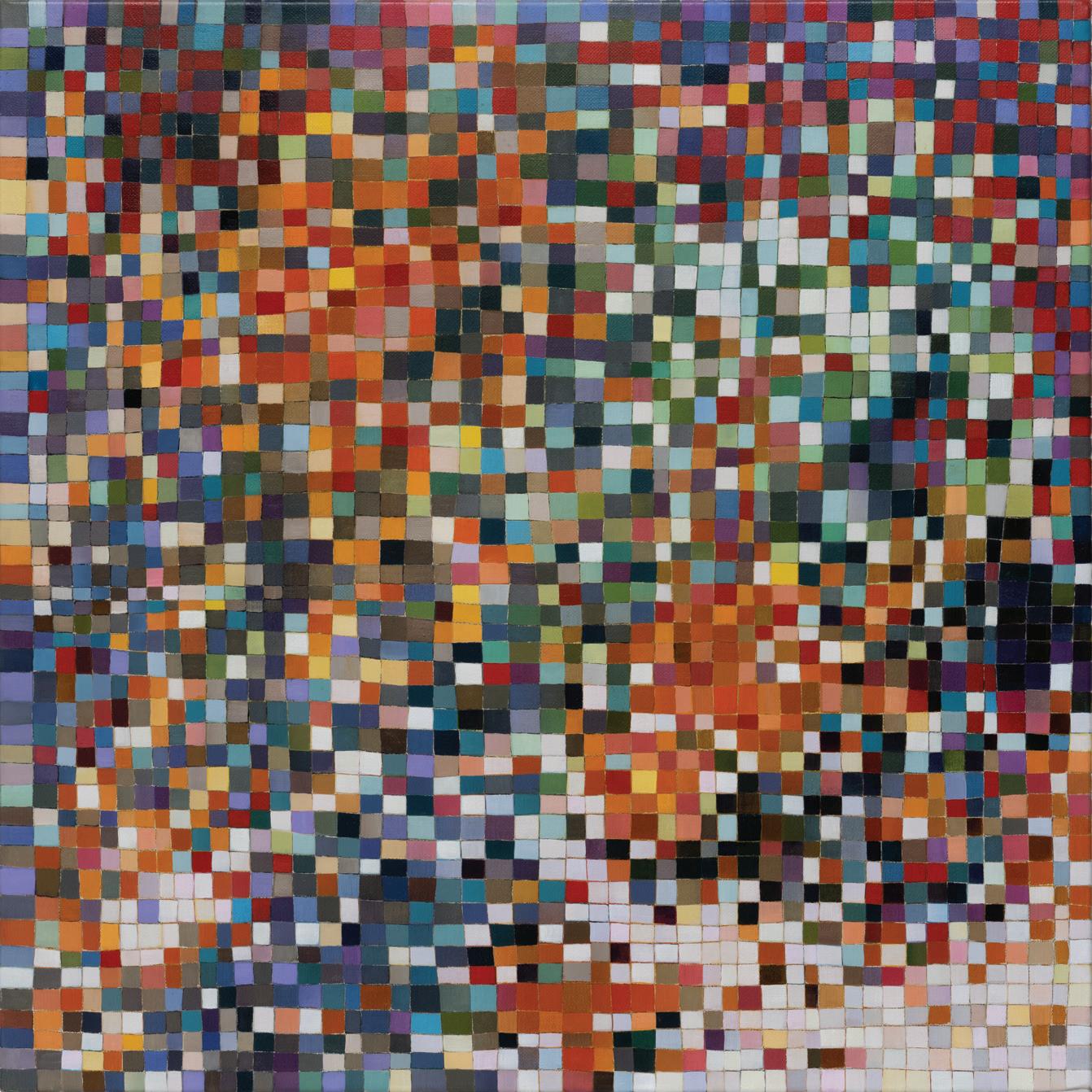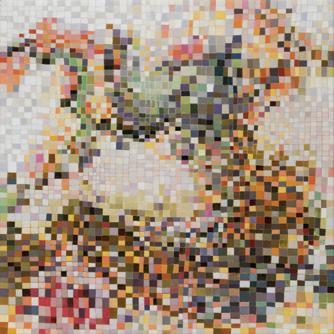
Surrounded by paintings as gorgeous and, frankly, covetable as Julia Ritson’s, how much thinking are we obliged to undertake? Must we force ourselves to come up with something difficult to say, because they’re abstracts? Can’t we just nod, tears prickling in our eyes, as we recall the beauty of what came over Paul Klee in Tunisia?
Something so deep, so gentle is entering into me; I feel it and that gives me a feeling of certainty, without effort. Colour has me. I no longer need reach out for it. It has me forever and knows it. That is the meaning of this happy hour. Colour and I are one.
Klee wrote these words in his diary in early 1914, seven or eight years after the Swedish theosophist Hilma af Klint made the first abstract paintings in modern Europe.
Artists took to abstraction around the time of the birth of psychoanalysis and an explosion of scientific knowledge about things previously invisible. There was a lot of thinking going on, and fresh notions of spirituality were proliferating. Increasingly, even people who only wanted to talk about the latest paintings were challenged. Presented with what was frankly a flat object missing a subject like a woman reading or a pier in the moonlight, amateurs had no alternative but to speak only of form, weight, balance, rhythm, tension and colour. Laypeople finding the works themselves inaccessible were likely to find artists’ statements about them even more abstruse, notably the long NeoPlasticism: The General Principle of Plastic Equivalence , written in 1920 by that most famous painter of judiciously positioned coloured squares and rectangles, Piet Mondrian:
Through the immutable in us, we are united with all things; the mutable destroys our equilibrium, limits us, and separates us from all that is other than us. It is from this equilibrium, from the unconscious , from the immutable that art comes. It attains its plastic expression through the conscious . In this way, the appearance of art is a plastic expression of the unconscious and of the conscious .
Say what?
Descriptive titles have always eased the process of thinking and conversing about paintings. In the case of abstracts, they can facilitate an enjoyable interlude – or lifetime, in the case of Hilma af Klint’s ‘The Swan’ 19141915 – of puzzling out how the work fulfils the promise or tease of the title, or the title pulls the elements of the work together. Dear Klee’s series of ‘Magic Square’ works have names including ‘Tower in Orange and Green’ 1922, ‘The Firmament Above the Temple’ 1922, ‘StaticDynamic Gradation’ 1923 and ‘Blühendes (Flowering)’ 1934. Piet Mondrian closed down this game, as one of the first artists to give his paintings uncompromising names such as ‘Composition A’ 1923 and ‘Composition B (No II) with Red’ 1935.
Except for a period between 2008 and 2013, over which she made a stunningly beautiful intermittent series of works related to fragments of Australian modernist paintings titled ‘Dorrit’, ‘Grace’, ‘Agnes’, ‘Roy’, ‘Ralph’ and so on, Julia Ritson has named her works ‘Untitled’. (Disclaimer: there is ‘Park’ 2013.)
Her exhibitions have mostly been titled Julia Ritson , New Works or a near equivalent. As a rule, she provides no artist’s statement. The rejection of all contextual collateral seems like a clue, even a guide, to how the artist would like her works to be received.
It’s hard work to look at these paintings without trying to discern hints of objects from the external world; to make nothing of them but themselves. Cursed brain, always forming connections! I try viewing them as if I were walking around with Josef Albers talking about colours presenting themselves in continuous flux, constantly related to changing neighbours and changing conditions. Truly wanting to see nothing but blocks of colour, I try hard not to see mountains, fragments of Pompeiian mosaic, a path into bush, city lights, a cottage border, some freeform Bargello needlework. I labour to suppress the fancy that the smaller units, squashed under or pressed between larger ones, squeak for more space. I try to forget the unforgettable, that ravishing sentence from Ulysses ending ‘through the checkerwork of leaves the sun flung spangles, dancing coins.’ If I remember picking up handfuls of smalti in a mosaicist’s workshop and watching them fall in brilliant drops through my fingers, or if I seem to feel the coolness of our bathroom floor as I lay on it when a child, it feels vulgar to say so. Mondrian’s Neo-Plasticism points, at least, to the dignity and gravity of the strongest abstract paintings, even tiny ones like Ritson’s. Quiet and limpid contemplation is their due, not a scramble to assimilate them into the personal history of the observer.
Klee, teaching at the Bauhaus in the early 1920s, wrote in his notebook ‘To paint well is simply this: To put the right colour in the right place.’ Julia Ritson paints well; remarkably, even, as she rarely makes a pencil plan on the canvas, and often uses the same brush to apply shapes of different hues, just giving it a hard wipe in between. Her gift for making seductive colours, setting them side by side and setting them in distant opposition is amazing.
To possess one of these paintings! The daily joy of trying to name its constituents: violet, puce, amethyst, aubergine, ruby, mauve, jade, eau-de-nil , powder, dollsbody, coral, apricot, on, on and on; the refreshment afforded by its emanation of equilibrium, and the fortifying influence of its suggestion of scaffolding. As a plastic expression of the immutable, it would, of course, make a still point in a room; but one full of excitement, like a caught breath. With close study, perhaps, would come the reward of a hallucinogenic, oblivious moment of unity with the insubstantial and subconscious: through mysterious colour, like scent, activating only one human sense, with no agency, no power, no being, no texture, no temperature, no form, just the ability to affect. The purity and benison of colour, in glowing squares, radiant polygons held in glorious suspension.

 UNTITLED 2102 , 2021
oil on linen
UNTITLED 2102 , 2021
oil on linen
UNTITLED 2103 , 2021

45 x 45 cm

UNTITLED 2104 , 2021
45.5 x 45.5 cm
oil on linen oil on linen UNTITLED 2105 , 2021
oil on linen
UNTITLED 2105 , 2021
oil on linen
 UNTITLED 2107 , 2021
oil on linen
UNTITLED 2107 , 2021
oil on linen
UNTITLED 2108 , 2021
oil on panel

20 x 20 cm each - diptych

 UNTITLED 2110 , 2021
oil on linen
UNTITLED 2110 , 2021
oil on linen
 UNTITLED 2114 , 2021
oil on linen
UNTITLED 2114 , 2021
oil on linen
 UNTITLED 2115 , 2021
oil on linen
UNTITLED 2115 , 2021
oil on linen
 UNTITLED 2116 , 2021
oil on linen
UNTITLED 2116 , 2021
oil on linen
 UNTITLED 2117 , 2021
oil on linen
UNTITLED 2117 , 2021
oil on linen
 UNTITLED 2118 , 2021
oil on linen
UNTITLED 2118 , 2021
oil on linen
UNTITLED 2202 , 2022
oil on linen
25.5 x 25.5 cm each - diptych

 UNTITLED 2204 , 2022
oil on linen
UNTITLED 2204 , 2022
oil on linen
 UNTITLED 2203 , 2022
oil on linen
UNTITLED 2203 , 2022
oil on linen
UNTITLED 2209 , 2022

oil on linen
46 x 46 cm
UNTITLED 2220 , 2022

oil on linen
46 x 46 cm
 UNTITLED 2221 , 2022
oil on linen
UNTITLED 2221 , 2022
oil on linen

UNTITLED 2223 , 2022
oil on linen
51 x 51 cm

UNTITLED 2224 , 2022
 oil on linen
oil on linen















 UNTITLED 2103, 2021 OIL ON LINEN | 45 x 45 cm
UNTITLED 2104, 2021 OIL ON LINEN | 45.5 x 45.5 cm
UNTITLED 2105, 2021 OIL ON LINEN | 45.5 x 45.5 cm
UNTITLED 2115, 2021 OIL ON LINEN | 51 x 51 cm
UNTITLED 2114, 2021 OIL ON LINEN | 51 x 51 cm
UNTITLED 2110, 2021 OIL ON LINEN | 41 x 41 cm
UNTITLED 2108, 2021 OIL ON PANEL | 20 x 20 cm each - diptych
UNTITLED 2107, 2021 OIL ON LINEN | 51 x 51 cm
UNTITLED 2116, 2021 OIL ON LINEN | 46 x 46 cm
UNTITLED 2117, 2021 OIL ON LINEN | 51 x 51 cm
UNTITLED 2118, 2021 OIL ON LINEN | 41 x 41 cm
UNTITLED 2202, 2022 OIL ON LINEN | 25.5 x 25.5 cm each - diptych
UNTITLED 2101, 2021 OIL ON PANEL | 40 x 40 cm
UNTITLED 2102, 2021 OIL ON LINEN | 45 x 45 cm
UNTITLED 2111, 2021 OIL ON LINEN | 76 x 76 cm
UNTITLED 2103, 2021 OIL ON LINEN | 45 x 45 cm
UNTITLED 2104, 2021 OIL ON LINEN | 45.5 x 45.5 cm
UNTITLED 2105, 2021 OIL ON LINEN | 45.5 x 45.5 cm
UNTITLED 2115, 2021 OIL ON LINEN | 51 x 51 cm
UNTITLED 2114, 2021 OIL ON LINEN | 51 x 51 cm
UNTITLED 2110, 2021 OIL ON LINEN | 41 x 41 cm
UNTITLED 2108, 2021 OIL ON PANEL | 20 x 20 cm each - diptych
UNTITLED 2107, 2021 OIL ON LINEN | 51 x 51 cm
UNTITLED 2116, 2021 OIL ON LINEN | 46 x 46 cm
UNTITLED 2117, 2021 OIL ON LINEN | 51 x 51 cm
UNTITLED 2118, 2021 OIL ON LINEN | 41 x 41 cm
UNTITLED 2202, 2022 OIL ON LINEN | 25.5 x 25.5 cm each - diptych
UNTITLED 2101, 2021 OIL ON PANEL | 40 x 40 cm
UNTITLED 2102, 2021 OIL ON LINEN | 45 x 45 cm
UNTITLED 2111, 2021 OIL ON LINEN | 76 x 76 cm
EXHIBITION
12 APRIL - 6 MAY 2023





ISBN | 978-0-6454880-4-3
© copyright 2023

SPECIAL THANKS
Dr Sarah ENGLEDOW
Shelley BEST
Stefano BOSCUTTI
Sophie FOLEY
Joanne RITSON





Joe BRENNAN
Portrait photography
Simon STRONG
Artwork photography
 UNTITLED 2203, 2022 OIL ON LINEN | 46 x 46 cm
UNTITLED 2204, 2022 OIL ON LINEN | 61 x 61 cm
UNTITLED 2222, 2022 OIL ON LINEN | 76 x 76 cm
UNTITLED 2301, 2023 OIL ON LINEN | 76 x 76 cm
UNTITLED 2209, 2022 OIL ON LINEN | 46 x 46 cm
UNTITLED 2223, 2022 OIL ON LINEN | 51 x 51 cm
UNTITLED 2224, 2022 OIL ON LINEN | 51 x 51 cm
UNTITLED 2221, 2022 OIL ON LINEN | 51 x 51 cm
UNTITLED 2211, 2022 OIL ON LINEN | 25.5 x 25.5 cm each - diptych
UNTITLED 2220, 2022 OIL ON LINEN | 46 x 46 cm
UNTITLED 2205, 2022 OIL ON PANEL | 20 x 20 cm each - diptych
UNTITLED 2210, 2022 OIL ON LINEN | 76 x 76 cm
UNTITLED 2203, 2022 OIL ON LINEN | 46 x 46 cm
UNTITLED 2204, 2022 OIL ON LINEN | 61 x 61 cm
UNTITLED 2222, 2022 OIL ON LINEN | 76 x 76 cm
UNTITLED 2301, 2023 OIL ON LINEN | 76 x 76 cm
UNTITLED 2209, 2022 OIL ON LINEN | 46 x 46 cm
UNTITLED 2223, 2022 OIL ON LINEN | 51 x 51 cm
UNTITLED 2224, 2022 OIL ON LINEN | 51 x 51 cm
UNTITLED 2221, 2022 OIL ON LINEN | 51 x 51 cm
UNTITLED 2211, 2022 OIL ON LINEN | 25.5 x 25.5 cm each - diptych
UNTITLED 2220, 2022 OIL ON LINEN | 46 x 46 cm
UNTITLED 2205, 2022 OIL ON PANEL | 20 x 20 cm each - diptych
UNTITLED 2210, 2022 OIL ON LINEN | 76 x 76 cm
For three decades, Ritson has explored the painted surface of the grid to capture contemporary and historical references through texture, colour, and form. This is her seventh exhibition at Scott Livesey Galleries.



Graduate of Victorian College of the Arts (Painting) - University of Melbourne.
Ritson lives and works in Melbourne, Australia.

